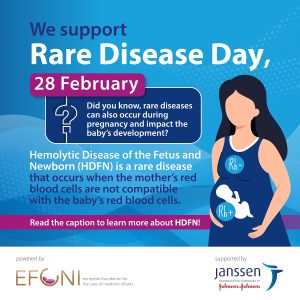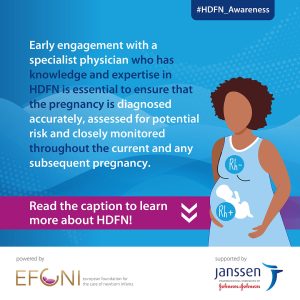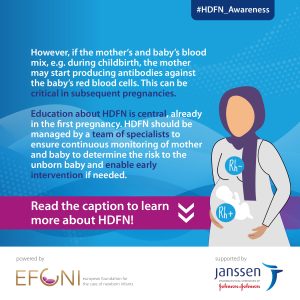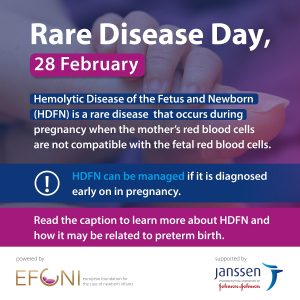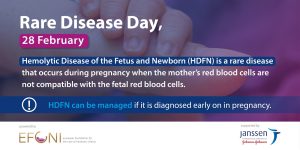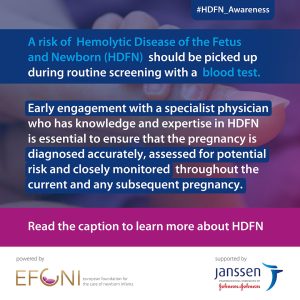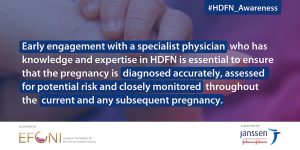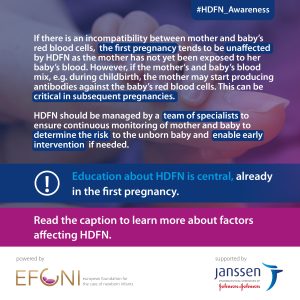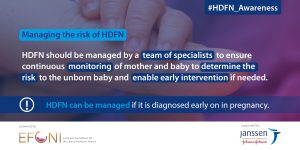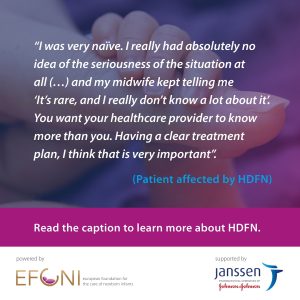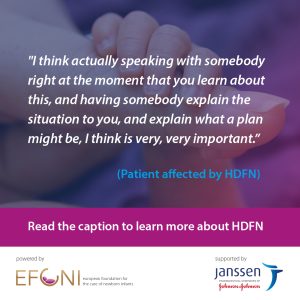HDFN is rare - Be aware - Ask for specialist care
Did you know that rare diseases can also occur during pregnancy? These diseases can have an impact on the development of the baby (fetus) while the mother is pregnant.
 One such condition, Hemolytic disease of the fetus and newborn (HDFN) occurs when the mother’s red blood cells are not compatible with the fetal red blood cells. It is not unusual for the mother and fetus to have different blood types. In rare cases where they are not compatible, the mother’s immune system sees the baby’s red blood cells as foreign and produces antibodies to fight these in a process called maternal alloimmunisation. This causes the baby’s red blood cells to break down quickly and leads to fetal anemia.
One such condition, Hemolytic disease of the fetus and newborn (HDFN) occurs when the mother’s red blood cells are not compatible with the fetal red blood cells. It is not unusual for the mother and fetus to have different blood types. In rare cases where they are not compatible, the mother’s immune system sees the baby’s red blood cells as foreign and produces antibodies to fight these in a process called maternal alloimmunisation. This causes the baby’s red blood cells to break down quickly and leads to fetal anemia.
Fetal anemia can increase the risk of preterm birth and lead to other complications; such as excess fluid in the organs and jaundice when the child is born.
Additionally, the mother’s immune system will store antibodies to fight babies red blood cells in future pregnancies. This is called sensitisation and fetal anemia can be more severe in future pregnancies than in the first affected pregnancy.
HDFN can be managed if it is diagnosed early on in pregnancy. If a pregnant woman is at risk of HDFN, then she should be referred to a specialist team of physicians. It is important that women at risk of HDFN are aware of this and seek referral to specialist care – this is the first step towards improving outcomes for mothers and babies affected by this rare disease.
 HDFN is a rare pregnancy condition which occurs when the mother’s red blood cells are not compatible with the red blood cells of her unborn baby (the fetus). In cases where they are not compatible, the mother’s immune system sees the baby’s red blood cells as foreign and produces antibodies to fight these, which, in rare cases can cause fetal anemia. Fetal anemia is when the amount of circulating red blood cells and hemoglobin in a fetus fall below normal levels. Because red blood cells transfer hemoglobin and oxygen through the blood to the tissues who need it, fetal anemia can have several adverse effects, including heart complications.
HDFN is a rare pregnancy condition which occurs when the mother’s red blood cells are not compatible with the red blood cells of her unborn baby (the fetus). In cases where they are not compatible, the mother’s immune system sees the baby’s red blood cells as foreign and produces antibodies to fight these, which, in rare cases can cause fetal anemia. Fetal anemia is when the amount of circulating red blood cells and hemoglobin in a fetus fall below normal levels. Because red blood cells transfer hemoglobin and oxygen through the blood to the tissues who need it, fetal anemia can have several adverse effects, including heart complications.
A risk of HDFN should be picked up during routine screening with a blood test. There are many different blood group systems. The ABO and Rhesus (Rh) systems are the most well-known and incompatibilities within these, as well as others, can lead to HDFN.
All women should have their blood group and antibody status determined at the beginning of their pregnancy.
If the mother’s blood group and antibody status indicate a risk of incompatibility with the baby’s, non-invasive fetal genotyping using maternal blood is carried out to confirm this. Paternal testing can be also completed to help identify the level of incompatibility. These tests will also enable identification of the type and extent of incompatibility and guide the course of care for the mother and baby.
Antibody levels should also be monitored throughout the pregnancy. If it is confirmed that the mother is producing antibodies against the baby’s red blood cells, a regular antibody titer test should be undertaken to determine the level of antibodies within her blood and thus, the level of risk to the baby.
With subsequent exposures between the fetus’ and mother’s blood, the levels of antibodies and thus the risk to the fetus may further increase, a process called sensitisation.
If sensitization occurs, the next time the woman is pregnant, her body produces antibodies immediately.
Early engagement with a specialist physician who has knowledge and expertise in HDFN is essential to ensure that the pregnancy is diagnosed accurately, assessed for potential risk and closely monitored throughout this and subsequent pregnancy.
 Hemolytic disease of the fetus and newborn (HDFN) is a rare pregnancy condition which occurs when the mother’s red blood cells are not compatible with the fetal red blood cells and this can lead to fetal anemia.
Hemolytic disease of the fetus and newborn (HDFN) is a rare pregnancy condition which occurs when the mother’s red blood cells are not compatible with the fetal red blood cells and this can lead to fetal anemia.
There is a range of severity associated with HDFN ranging from mild to very severe. In the most severe cases, fetal death from heart failure may occur.
If there is an incompatibility between the mother and her baby’s red blood cells, the first pregnancy tends to be unaffected as the mother has not yet been exposed to her baby’s blood. Women may not even be aware of the incompatibility with their newborn!
However, upon exposure to their baby’s blood e.g. during childbirth, mother and baby’s blood can mix. In the case of incompatibility, this may cause the mother to start producing antibodies against the baby’s red blood cells which can be dangerous in subsequent pregnancies. Therefore, it is really important that women are educated on the risk of HDFN starting already from the first pregnancy. For women with RhD incompatibility, preventive therapy can be administered which prevents the mother’s immune system from attacking the fetus.
Additional factors which can affect the severity of the disease include:
- The type of antibody that a mother produces – some types of antibodies carry higher risk than others and some can be treated with a preventive therapy
- Antibody titers – the level of antibodies in the blood should be measured regularly throughout pregnancy as in some cases, higher levels are linked to increased severity and risk of fetal anemia (too low number of red blood cells)
- The number of previous pregnancies affected by HDFN – the severity of HDFN tends to be higher with each subsequent pregnancy
There are many steps that your specialist physicians and their teams can implement to monitor the disease and manage any potential associated risks. Antibody levels should be monitored throughout the pregnancy. Regular ultrasounds of the middle cerebral artery (MCA) Doppler should also be undertaken by a specialist physician to monitor the baby’s blood flow and detect any presence of fetal anemia.
HDFN should be managed by a team of HDFN specialists to ensure continuous monitoring of the mother and baby to determine the risk to the fetus and enable early intervention if needed.
| hemolytic | referring to destruction of blood cells |
| fetus | unborn baby |
| fetal | referring to the unborn baby |
| compatible | matching to each other |
| antibody
|
component of the immune system that identifies and attacks objects recognised as foreign/non-self in the human body |
| blood type
|
also known as blood group: differences in structures on the surface of human red blood cells |
| maternal alloimmunisation
|
process when a pregnant women’s immune system produces antibodies against the red blood cells of her unborn baby |
| anemia | too low number of red blood cells or hemoglobin resulting in reduced oxygen-carrying capacity in the blood |
| premature birth | birth of a baby before the completion of 37 weeks of gestation |
| jaundice
|
due to the build-up of a yellow pigment in the body (as consequence of destruction of red blood cells) skin and eyes appear yellowish |
| sensitisation
|
process of becoming reactive to substance (in the case of HDFN the mother’s immune system becomes reactive to the blood type of her unborn baby) |
| haemoglobin
|
protein in red blood cells that helps to transport oxygen and carbon dioxide within the human body |
| non-invasive
|
procedure that does not require injuring the skin or entering the body |
| genotyping
|
analysing a person’s DNA/genetic variation. This information can help determine an individual’s predisposition to certain diseases through a simple blood test |
| paternal | regarding the father |
| incompatibility | inability of two substances or entities to coexist or function together harmoniously |
| antibody titer | level of antibody in the blood |
| exposure | coming into contact |
| RhD | refers to the presence or absence of a specific structure (a protein called “D antigen”) on the surface of red blood cells |
| preventive | measures taken to avoid that a disease or condition occurs or worsens |
| administered | given or applied |
| severity | seriousness or intensity of a medical condition or symptom |
| ultrasound | a diagnostic imaging technique that uses high-frequency sound waves to create images of internal organs, tissues or unborn babies |
| middle cerebral artery | an artery in the brain |
| Doppler | A technique used in medical imaging that uses sound waves to measure blood flow |
From an expert's point of view
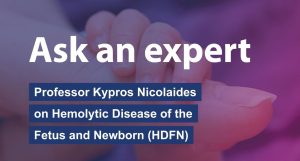
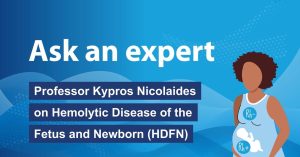
We spoke with Kypros Nicolaides, Professor in Fetal Medicine at King’s College, London, UK and Founder and Chairman of the Fetal Medicine Foundation, about the role of specialist centres, when a pregnant woman at risk of HDFN should be referred to such a centre, and what specialist centres do with regards to diagnosing and monitoring HDFN. In addition, we asked him what women, diagnosed with HDFN, can do to support their pregnancy.
Watch his statements here in our HDFN playlist
Expert statement for health professionals
Expert statement for women at risk of HDFN
From a patient's point of view
A pregnant woman was informed by her midwife she had antibodies in her blood from a routine blood test five weeks into her pregnancy. However, she didn’t actually know that she was at risk of developing Hemolytic Disease of the Fetus and Newborn (HDFN) because she didn’t realize the implications of the antibodies. In her initial interactions with healthcare professionals nobody mentioned HDFN, all she knew was that it could affect her pregnancy and her baby.
 “I was very naïve. I really had absolutely no idea of the seriousness of the situation at all. I was told this is very rare. Your community midwife is usually your first line of contact for maternity care. Some people never see an obstetrician, or a fetal specialist at all. I was going through my midwife initially, and my midwife kept telling me ‘It’s rare, and I really don’t know a lot about it’. The midwifery team really didn’t know about HDFN at all, or the antibody situation.”
“I was very naïve. I really had absolutely no idea of the seriousness of the situation at all. I was told this is very rare. Your community midwife is usually your first line of contact for maternity care. Some people never see an obstetrician, or a fetal specialist at all. I was going through my midwife initially, and my midwife kept telling me ‘It’s rare, and I really don’t know a lot about it’. The midwifery team really didn’t know about HDFN at all, or the antibody situation.”
HDFN is a rare disease affecting only 2.5 per 100,000 births in high-income countries which means that often the primary healthcare provider may not have the information on the disease because they have seen so few patients with the condition.
“I think just trying to work it out myself, myself and my husband – we were trying to work out – what does this mean? What’s this going to look like going forward? I don’t feel like I had the information to really understand the situation, …the severity of the situation and I certainly don’t remember HDFN being talked about.”
That is why it is important for healthcare professionals to be aware of the disease and understand the importance of referral to specialist care so that women with HDFN can get the information they need at the right time.
Disclaimer: The quotes are actual insights from participants in a Global Patient Council that have lived experience with HDFN. These insights were collected and anonymised in September 2021
When you are pregnant and you hear you have antibodies and you may be at risk for developing Hemolytic Disease of the Fetus and Newborn (HDFN) it is important you are well informed on the condition.
 “I didn’t find a huge amount of information on the internet at that point, but I didn’t research as much at that point as much as I realize I should have now. After we lost our second little boy, I started research myself into antibodies and HDFN. I looked at medical research papers, and found a doctor who’d done some research. I think actually speaking with somebody right at the moment that you learn about this, and having somebody explain the situation to you, and explain what a plan might be, I think is very, very important.”
“I didn’t find a huge amount of information on the internet at that point, but I didn’t research as much at that point as much as I realize I should have now. After we lost our second little boy, I started research myself into antibodies and HDFN. I looked at medical research papers, and found a doctor who’d done some research. I think actually speaking with somebody right at the moment that you learn about this, and having somebody explain the situation to you, and explain what a plan might be, I think is very, very important.”
In this particular case, the affected woman was able to track down an HDFN specialist who gave her the information she required and provided better monitoring throughout her subsequent pregnancies to ensure she received the specialist care she needed. She concludes
“You want your healthcare provider to know more than you. Having a clear treatment plan, I think that is very important”.
She continues about how she perceived care at a specialist centre:
‘They asked me a lot of questions, I think to see what my understanding was, as well, in terms of my condition. But they also really respected my own knowledge about my condition, and about how that could affect my pregnancy, and really involved me into that situation. This is a just a very basic consultation so that I could fully understand what my condition was. ‘
That is why it is important for patients to be aware of the disease and understand the importance of referral to specialist care so that women with HDFN can get the information they need at the right time.
Disclaimer: The quotes are actual insights from participants in a Global Patient Council that have lived experience with HDFN. These insights were collected and anonymised in September 2021
Social Media Graphics
Graphics for parents and patients
You want to support HDFN awareness? We invite you to download the social media materials and post/share them in your own social media messages. Please tag us @efcni to help us find, like, share, and support your posts!
Graphics for medical professionals (square and landscape/Twitter format)
NOMINATE – call for participants in Patient/Parent Advisory Board
The NOMINATE project (“Novel Outcome Measures IN AuToimmune DiseasE”) seeks to identify the most relevant outcomes in management of the alloimmune condition of HDFN and specifically, to understand the impact of this disease on parents and newborns.
How to participate
Learn how you as a patient can participate and contribute to this project and visit our project page
Further information
Information sheet (EN)
Information sheet (DE)
Further reading
For patients
For medical professionals
Article on Management of Women with Red Cell Antibodies during Pregnancy (RCOG)
The HDFN awareness campaign was independently developed and is powered by EFCNI.
![]()
Supported by:




